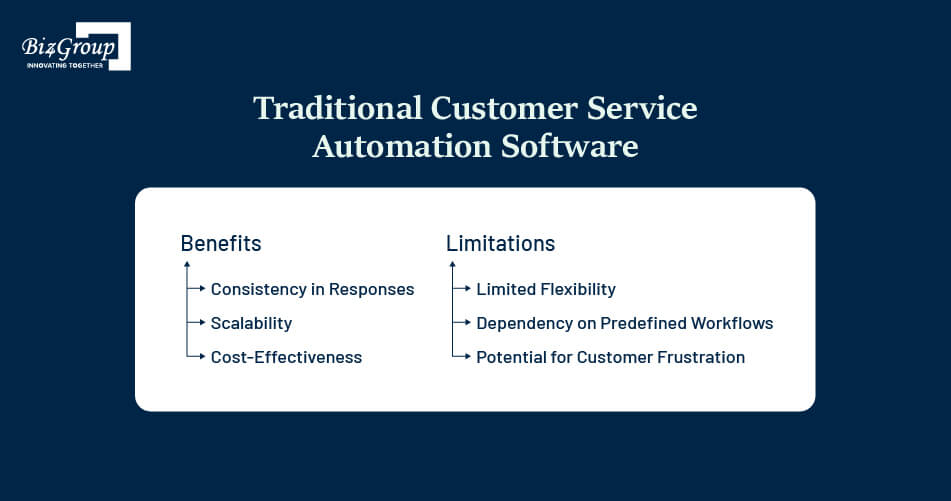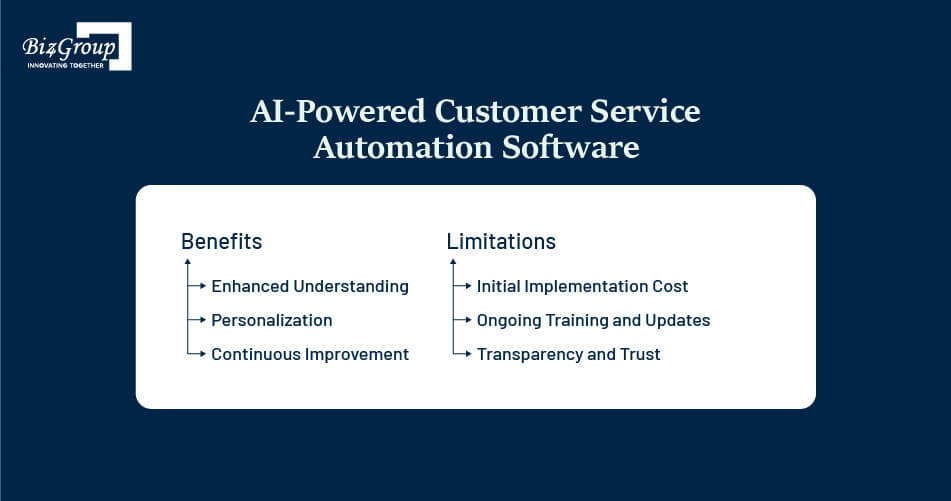Basic AI Chatbot Pricing: A simple chatbot that can answer questions about a product or service might cost around $10,000 to develop.
Read More
Customer service automation solutions use artificial intelligence to efficiently handle customer interactions. This is important for today’s business as they can handle many inquiries in a short time, hence cutting down on the waiting time, not to mention customer satisfaction. Automation tools are as simple as email and ticketing systems as well as sophisticated AI-based chatbots that cater to each customer individually.
The major aim of customer service automation software is to attend customer queries efficiently and to reduce the burden on human operators while doing so. With the help of common questions/ tickets response, businesses can save human resources’ time and address those more intricate matters that demand a personal approach.
Compared to traditional customer service, AI in customer service can deal with complicated queries in faster and more efficient ways compared to normal procedures and could lead to 50% reduction in the response time.
According to Salesforce, over 90% of businesses with AI have reduced expenses, increased efficiency, and enhanced customer experience. Furthermore, 90% of service professionals believe that technology will assist them in delivering efficient customer service. (Source)
 (Source)
(Source)
Traditionally customer service entails the use of software tools to respond to customer inquiries in a structured manner. These include ticketing systems, email automation, and live chat. These tools assist in reducing the support flow and guarantee that client inquiries are responded to adequately.

Consistency in Responses: Traditional systems give preset answers to common questions helping customers have relevant information through the IVR system. As a result, customer satisfaction becomes predictable and constant because the delivery of customer services is consistent regardless of the staff or shift.
Scalability: These systems can process so many requests within a short period of time and as such are suitable for organizations that experience high traffic on their communication channels. For instance, a ticketing system can capture the type of tickets and rank them based on their level of importance so that crucial issues are solved first while others are pending.
Cost-Effectiveness: Traditional customer service automation greatly decreases operational costs. This is especially good for small and medium-sized companies that cannot afford to have a department dedicated to customer support. Automation also supports more efficient resource management that helps human agents deal with more intricate cases that require a human approach.

Limited Flexibility: Traditional systems often lack agility to deal with tasks which do not fit business processes. The rigidity can sometimes be a disadvantage when handling specific and advanced customer issues that may not necessarily follow the normal format. For instance, a customer with a unique problem might get annoyed to go through a number of automated messages which do not reply to his/her issue.
Dependency on Predefined Workflows: These systems rely greatly on the efficiency of the script as well as the business workflows put in place. This implies that if the scripts are badly developed or the workflows are not well coordinated the system’s efficiency is affected. For the solutions to be effective and efficient, constant updates and maintenance of the workflows are needed.
Potential for Customer Frustration: Traditional automation systems do not provide query customization capabilities and may be unable to handle more detailed and extensive queries. Lack of personalization can cause frustration and disappointment among the customers. For instance, a customer who may think that they are the only one with a particular question or issue may get annoyed to receive general answers that do not apply to their situation.
Also Read: The Role of AI in Project Management
It uses machine learning, natural language processing, and predictive analytics to handle customer relations. They can perform natural language comprehension, interact based on prior transactions, and deliver individualized services.

Enhanced Understanding: AI in customer service can process even the most complex questions and queries, improving the quality of responses provided, and customer satisfaction.
Personalization: AI powered automation in customer service adjusts its actions according to the customer’s action and past purchasing behavior with tailored solutions and recommendations. This level of personalization takes the relationship between the business and the customers to another level, because the customers will feel like they are valuable. For instance, an AI system can suggest products or services based on a buyer or a customer’s past choices.
Continuous Improvement: This means that each time customers engage with those systems, the systems are also learning and growing wiser. The tools are precise, and as time passes, they work more and more efficiently, thus helping to improve customer satisfaction.
Initial Implementation Cost: AI systems require a big investment and time to be incorporated into an organization. This cost is incurred in acquiring the software and tools, installing and implementing the software in the organization’s systems, and providing staff with the knowledge and skills to operate the software. Business should also factor in the costs associated with recurring maintenance and upgrading the Artificial Intelligence system for efficiency.
Ongoing Training and Updates: Machine learning models meant for AI need to be updated periodically so that they remain relevant and quite accurate.
Transparency and Trust: Certain clients may not be comfortable, especially when using AI in decision-making processes.
Partnering with an AI development company can help mitigate these costs by providing expertise and optimized solutions.
Also Read: Aircraft Maintenance Tracking Software – Guide by Biz4Group
The comparative analysis of traditional and AI powered customer service automation consists of multiple factors. Let’s explore them in detail:

In terms of effectiveness, AI-powered customer service automation is often more effective than traditional customer service processes. While traditional database systems are optimal for basic queries, the process of handling complex questions involves human input.
Traditional systems are easy to implement, especially as they don’t allow for much flexibility because the workflow is pre-defined. This approach is more suitable for consumers, as AI devices are designed to be more intuitive for users to interact with. Some examples are, using AI chatbots to lead the user through a process while requiring virtually no engagement from the user.
Both systems are scalable, but the ai-powered customer service automation software is considered to be more flexible. As the number of customer queries grows, the use of AI can handle them without a corresponding spike in resource demand. High volume is not a problem for traditional systems, but they may need extra hardware and personnel to support it well.
Although the use of AI-powered customer service automation software may require more initial funds in terms of setup, they can turn out to be cheaper in the long run. They minimize the use of a substantial support staff and have lower operational costs in the long run.
On the other hand, traditional systems could initially be purchased and installed at relatively low costs but could often require regular maintenance and assistance, which would increase costs in the long run. Consulting with a generative AI development company can help businesses to manage the cost and deliver quality AI-powered systems.
AI and automation in customer service improve interactions by adapting to specific customers. While the conventional systems are effective, they do not allow for customization of services, thereby posing inconveniences to consumers.

The future trends in customer service automation consist of various aspects. Let’s discuss them one by one:
Regarding the current tendencies in ai-powered customer service automation, AI and machine learning can be credited as the essential trends that will influence the development of the field. The AI algorithms are getting improved, this enables recording of the flow of the conversation and providing appropriate responses in the queries made by the customers.
Advancements in machine learning algorithms will help AI systems to handle interactions with customers that would previously have been deemed as sophisticated.
Other benefits will include using machine learning to forecast customer needs and provide relevant solutions to the customers to improve the experience.
There can be various aspects of customer expectations like instant gratification, personalization and omnichannel support. Let’s know them in detail:
Most customers seek quick solutions to an issue or question, and this can be well provided by AI.
There has been a shift toward people wanting products and services tailored for them. This will be the main capacity of AI in the capacity of responding and suggesting products based on customer behavior.
Customers expect support to be as integrated as the channels of support provided including social media, emails, and chats. These channels can also be integrated by AI-powered systems to make the integrated system more harmonious.
We at Biz4Group, build AI chatbot for customer service. It can help you to ease your work and make the process faster and smoother with instant responses and solutions to critical problems.

When comparing traditional and AI-powered customer service automation tools, it is easy to identify the benefits and drawbacks of such solutions. Traditional systems, which are generally reliable and sustainable, autonomously process 60% of queries but are insufficient for addressing intricate or odd requests.
However, AI powered systems are better suited to handle complex questions, providing a tailored experience and learning from the interaction process. They can decrease response time by 50% and increase customer satisfaction by 40%.
Therefore, when comparing the two, businesses must think of certain factors they would use while having the issue at hand. Traditional customer service automation software is applicable to companies with elementary customer service needs and scant resources, while options based on ai powered customer service automation correspondingly will suit mostly all kind of organizations, which aim to boost customer relations through the application of the superior technology and individual approach.
Hence, it is advisable for businesses to hire professional custom chatbot development services to get the best experience. These services provide an AI solution that is best suited to the business which aims at improving customer relations and business performance.
IN YOUR BUSINESS FOR FREE
Our website require some cookies to function properly. Read our privacy policy to know more.